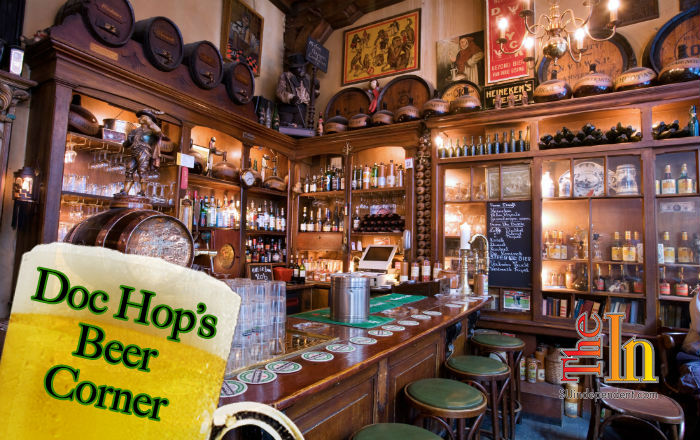It is fitting that my first foray into the world of writing is a beer column. As may become painfully apparent – when it comes to writing for public consumption I am a virgin. Pure as the driven snow. By contrast, when it comes to beer, my experience is wide and occasionally strays into the prolific. A beer whore if you will! I love all things beer. I love how it looks, how it smells and tastes. I love how it streams from the tap and hits the bottom of the glass in a mesmerizing swirl. Gripping the cold heavy pint glass prior to your first taste is an exercise in anticipation and restraint. I love the places you drink it and the people you drink it with. The cold and calculated inebriation of sipping wine and cocktails pales in comparison to the warm embrace of a good beer buzz and the boisterous conversation that is bound to follow.
For all my current beer passion, I wasn’t always a true beer lover. Like most people who start drinking beer, in my young adulthood the goal was often inebriation rather than appreciation. Along those lines, my beer drinking choices were driven more by the change I could find in the couch cushions rather than the quality of the beer I drank. Initially I merely tolerated beer. It was a means to an end, but the taste of beer would not have ranked high on my list of things to eat or drink.
My beer world changed when I accepted an offer to train at a medical residency at Dartmouth. A cross-country trip landed my family in a small New England town with lots of cold nights and cozy pubs. My first experience with fresh craft beer was from a local brewery enjoyed in a small pub on the village square of our new town. It was a tall foamy pint of Harpoon IPA.
I still remember that first pint. That first chilled pint offered up piney and fruit like hop smells on the front end with a wonderful mix of bread and caramel malt taste on the back end leaving a subtle lingering bitterness that made me want to take the next swallow. The experience for me was that memorable! And though I would explain it that way now (after 15 years of drinking craft beer and brewing a few hundred gallons of beer myself), back then all I thought was – holy crap this is good!! Why have I been drinking beer for so many years and I’m just now finding out how good it can be? I was happy to drink it, but I lamented for all of my lost beer drinking time. I felt cheated. Bamboozled!
I suspect this is a common story for any beer drinker growing up in Utah prior to the late 90’s. It wasn’t just a lack of funds that gave me a poor beer drinking experience, but also a profound lack of choices and antiquated laws that limit the type of beer that can be poured from a tap. But that was then and this is now. While some things haven’t changed (still can’t get full strength beer on tap), the world of Utah beer has profoundly changed in the last 15 years. Like most things in Utah, this mirrors (but slightly lags behind) trends elsewhere in the country.
You and I, my thirsty friend are privileged enough to be living through one of the great cultural revivals of modern history. The resurgence, revival and dare I say world dominance of American craft beer is happening right in front of our eyes. We are literally emerging from what I call the light ages (the dark ages of beer) where the only beer that you could find was the color of dilute urine and smelt similar to stagnant pond water. Ask any travelling European what they think of commercialized beer in this country – and 90% of the time the response is the same – tastes like cat piss! This bit of unbiased feedback makes you question how our country has been brainwashed into drinking this stuff for so long while simultaneously contemplating the apparent shockingly intimate relationship between Europeans and their cats.
With rapidly increasing momentum, craft breweries and home brewers are taking back American brewing from brewing conglomerates. Prior to prohibition, local breweries abounded – with estimates of around 4500 local breweries in the early 1900’s. After prohibition only about 700 local American breweries survived. The next 50-60 years saw an unprecedented consolidation of breweries as large companies and conglomerates either bought breweries up or put them out of business by aggressive local price reduction. This closely mirrored the consolidation of our food sources in this country (a subject for another day).
By the early 80’s the number of breweries was reduced to about 50. The vast majority of these breweries essentially sold the exact same product. As the beer historian Michael Jackson (no relationship to Teto!) wrote of beers of that era: “They are pale lager beers vaguely of the pilsner style but lighter in body, notably lacking hop character, and generally bland in palate. They do not all taste exactly the same but the differences between them are often of minor consequence.”
Fortunately for us, there were the inevitable American mavericks ready to buck the trend. Owners and brewmiesters of early microbreweries – Anchor Steam, Boston Brewing Company and Sierra Nevada brought back traditional ales of complexity, challenging the ubiquitous tasteless (but heavily marketed) product available to consumers. It was an uphill battle, with very little traction in the 80’s but clearly gaining steam by the early 90’s. Currently, one of the most recent counts shows over 3000 microbreweries in the country. We are back baby! This trend was started and heavily supported by home brewers – many of whom took the leap into commercial brewing. The current craft brewing revival has its roots planted firmly in home brewing and home brewing its self has exploded at an even greater rate than the expansion of microbreweries.
Suffice to say, your options for good beer are now better than they have been in over 100 years. American brewers are pushing the limits of all styles of beer – even inventing new ones and recreating 1000-year-old styles of beer through beer archeology. My hope in writing this column is to bring to light all things beer. Everything is on the table – tasting, history, politics, brewing techniques etc… Tune in for the next batch – where we will cover the basics of what goes into beer and a primer on beer tasting. Grab yourself a craft beer, get it in the fridge and get ready to pop the top, pour it and drink it while you read the next instillation. God knows I will be doing the same while writing it! Hopefully we all can start drinking our beer with better appreciation and with rapt intention.
If you have made it this far in the article you probably already enjoy beer or drink some type of alcohol, or are just beer curious. My second hidden agenda is to convert all of you who wrinkle your nose when offered a beer into the fold of beer lovers. With the heart of a zealot – I believe that if you drink – you already like beer. You just may not know it yet!
A parting Irish toast: Here’s to a long life and a merry one. A quick death and an easy one. A pretty girl and an honest one. A cold pint– and another one! Cheers, Doc Hop
Jeremy Hopkin grew up in the heart of happy valley (Orem, UT). He received his undergraduate degree in zoology, got his M.D. degree from University of Utah, and did his residency in radiology at Dartmouth including a fellowship in neuroradiology. He is currently employed locally as a diagnostic radiologist and also treats varicose vein disease at Red Sands Vein and Laser Institute. He gives training and nutritional advice to athletes of all ages, shapes and sizes at Crossfit St. George and loves to help people attain their health goals. He is fascinated with science and is a tinkerer in all things fermentation. He’s been a home brewer for 7 years and is a beer lover for life!
More from “Doc Hop’s Beer Corner”





